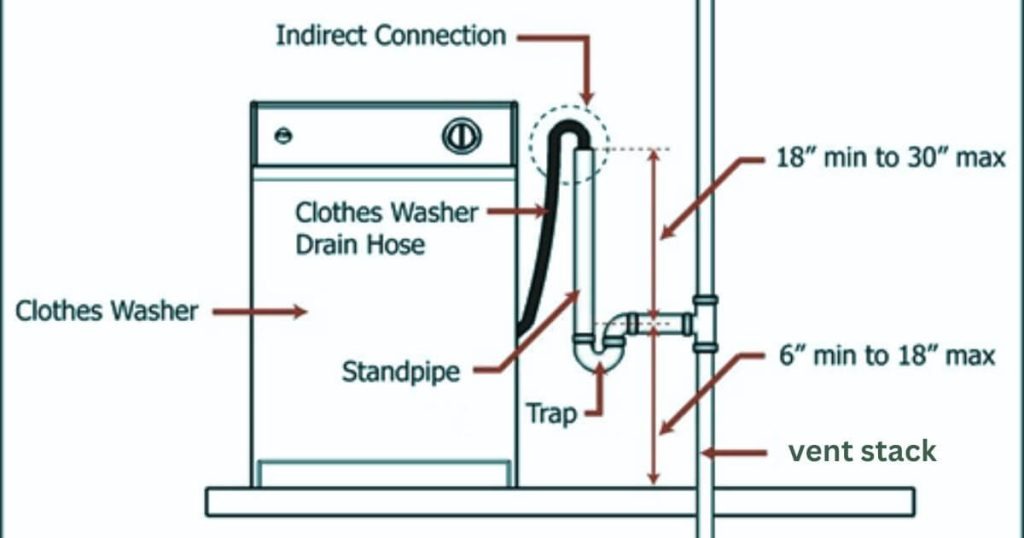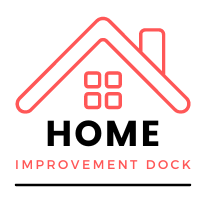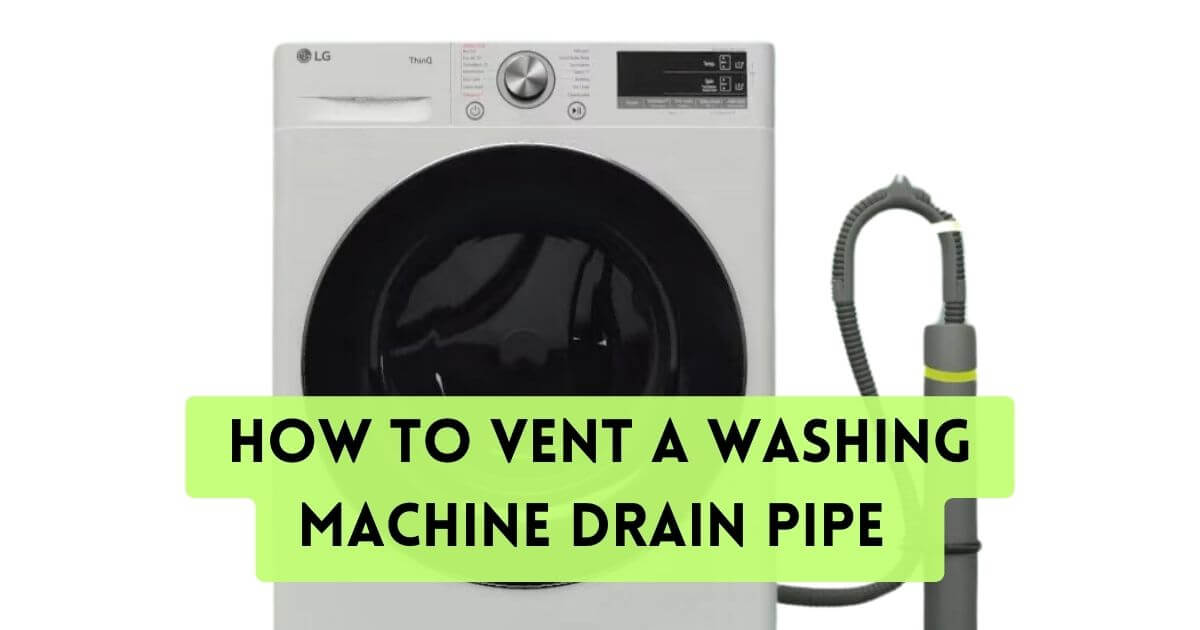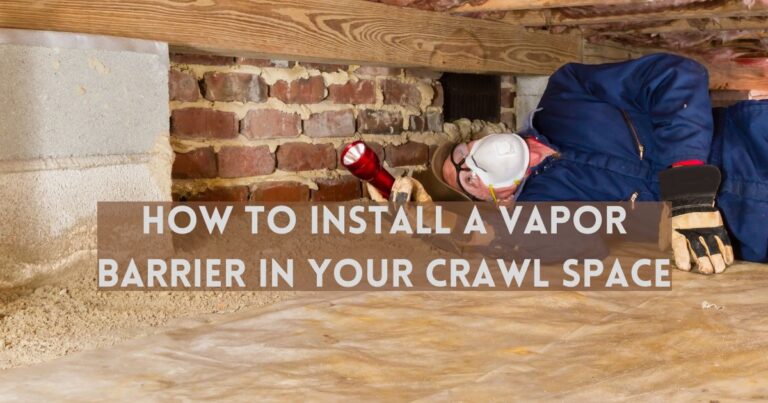How To Vent A Washing Machine Drain Pipe
So, you now know properly venting the drain pipe allows sewer gases to escape safely, preventing them from backing up into your home and releasing air pressure in the drainage system. But how do you do it?
How to vent a washing machine drain pipe – here are the steps to follow:
- Disconnect power and water
- Locate drain pipe
- Route into the vent stack
- Install P-trap and standpipe
- Add AAV if needed
- Test drain installation
As you can see, the process is easy to follow. This guide will take you through these steps. Let’s jump right in!
How To Vent A Washing Machine Drain Pipe
The easiest and most effective way to vent a washing machine drain pipe is to run the drainpipe into your home’s vent stack, which is one of the basic home plumbing requirements. The vent stack allows sewer gases and built-up air pressure to escape the home, preventing potential leaks or mess. If you want to ensure this never happens to your home, follow the steps outlined here.

The image above shows everything you need to connect. It will be your guide and reference. It summarizes the steps for you. Remember, it is for those who don’t have a drain the washer can drain to.
Step 1: Disconnect Power and Water Supplies
The first step is safety. You must disconnect the power and water supplies to the washing machine before beginning any installation or modification of the drainpipe. Unplug the washer to avoid potential electric shock from water exposure. Disconnect the water hoses from the hot and cold water lines. Shut off the water supply valves and release any pressure in the lines. This ensures you work with dry plumbing components to prevent flooding or electrical hazards during venting.
Step 2: Locate the Drain Pipe
With the washer disconnected, locate the existing drain pipe that routes water out of the machine. This is typically a gray plastic or rubber hose that runs from the rear of the washing machine—Trace where this pipe currently drains water, such as into a wall or floor drain. If you have a drain line, you need to connect it to the vent stack. If you don’t have a drain line, skip to step 4.
Step 3: Run the Drainpipe into an Existing Vent Stack
The preferred method for venting a washing machine drainpipe is to route it directly into the home’s existing vent stack. This vertical pipe routes sewer gases and pressure safely through the roof. Connect the washing machine drainpipe to the vent stack using a straight pipe run. Ensure an airtight connection is critical so the vent functions to prevent backflow or bursting in the plumbing lines.
Step 4: Install a Standpipe and P-Trap
A P-trap is required to provide the drainage barrier between the home’s plumbing system and sewer gases. To install it, use an adapter fitting to connect the long-end PVC P-trap to the vent stack. Consider installing it 6 – 18 inches above the floor. Proper placement of the P-trap is important so it effectively traps water to form the drainage seal. Get an 18-30-inch standpipe with a bigger diameter than the washing machine drain pipe. This is crucial as getting a fitting will create a seal that will siphon the washer from the washer during cleaning. Connect the p-trap curved end vertically, as shown in the image.
Step 5: Install an Air Admittance Valve (AAV) if Needed
If routing the drainpipe directly into the vent stack is impossible, an AAV can provide the needed ventilation. This one-way mechanical vent allows air in but not gases out. Use an adapter fitting to secure the AAV onto the drainpipe after the P-trap. Note local plumbing codes regarding AAV usage, as some areas do not permit them.
Step 6: Test the Drain Once Installation is Complete
Once the venting components are installed, insert the washer drain pipe into the standpipe, reconnect the washing machine by reattaching its water supply hoses, and restore power. Run a full cycle and inspect the new drainpipe connection for any leaks. Check that the washer fills, agitates, spins, and fully empties without issue. Observe the vent stack as well to ensure it is functioning properly. If all performs well, the venting installation is complete. Resolve any drainage issues before finalizing the project.
RELATED: Water Coming Back Up Kitchen Sink? Try This 5 Easy Steps!
When Should I Vent My Washing Machine Drain Pipe?
You should vent your washing machine drain pipe if you notice any of the following signs:
- Gurgling sounds: The noise can indicate that the water is not flowing properly through the drain pipe, and the air is getting trapped in the system.
- Foul odor: A bad smell coming from the drain pipe may indicate inadequate ventilation or a clog.
- A small puddle of water: If you notice a small pool of water near your washing machine, it could result from inadequate drainage.
- Slow drainage: This can happen in severe cases, and if your washer drains very slowly, you should call a plumber immediately.
How Much Does Venting a Washing Machine Drain Pipe Cost?
Venting a washing machine drain pipe can cost between $230 and $1,235, including the required building permits. The cost may vary depending on the specific needs of the plumbing system.
Here is a breakdown of the potential costs:
| Task | Price Range |
|---|---|
| Drainpipe Replacement | $230 to $1,235 |
| Building Permits | $30 to $150 |
| Plumber’s Service | $45 to $200 |
| Materials (e.g., pipe) | $0.75 to $30 per linear foot |
The cost of venting a washing machine drain pipe depends on various factors, including the need for drainpipe replacement, building permits, and the plumber’s service. It’s important to consult a professional plumber to assess the specific requirements of your plumbing system and obtain an accurate cost estimate.
For a more detailed breakdown, the potential costs can be categorized as follows:
- Drainpipe Replacement: The cost of replacing a drainpipe ranges from $230 to $1,235, including the required building permits.
- Building Permits: Building permits for the venting process can cost between $30 and $150, depending on the local regulations and requirements.
- Plumber’s Service: Hiring a professional plumber for the venting process could cost between $45 and $200, depending on the complexity of the job and the plumber’s service rates.
- Materials: The cost of materials, such as the drain pipe itself, can range from $0.75 to $30 per linear foot, depending on the specific requirements of the plumbing system.
It’s important to note that the actual cost may vary based on the unique circumstances of each venting project. Therefore, obtaining a detailed cost estimate from a licensed plumber is recommended based on a thorough assessment of the specific plumbing needs.
RELATED: Why Is My Sink Leaking Underneath? Here Are 9 Reasons Why!
When Do I Call A Professional?
There are several situations where it is generally best to hire a professional plumber rather than attempt to vent your washing machine drain pipe yourself. Here are some:
- If routing the drainpipe into an existing vent stack is not feasible due to the layout of your home’s plumbing system. A licensed plumber will be better equipped to assess alternatives and install additional ventilation components properly.
- If your drainpipe requires replacing due to age, corrosion, or other issues. Installing a new one often involves manipulating plastic or metal piping in tight spaces where experience and expertise make a difference in avoiding potential damage to surrounding areas.
- A permit may be required for certain plumbing modifications, depending on your local building codes. Getting a plumber will ensure all work is fully code-compliant.
- If you do not have the necessary skills or tools to cut and join piping securely, conduct powerful drain tests, or work around live plumbing or electrical lines safely. A licensed plumber can take away the hassle.
Conclusion
Properly venting the washing machine drain pipe is an important plumbing task that prevents drainage issues and unpleasant odors in the home. While the process seems straightforward, some homeowners may lack the expertise or tools to complete the job safely. If any part of the venting project seems beyond your abilities, it is best to hire a licensed plumber. Their training and experience ensure code compliance and that your home’s plumbing works as intended for many years to come.




![How Do You Maintain Your Lawn? [5 Easy Steps]](https://www.homeimprovementdock.com/wp-content/uploads/2023/03/how-to-maintain-a-lawan-featured-image-768x384.jpg)

